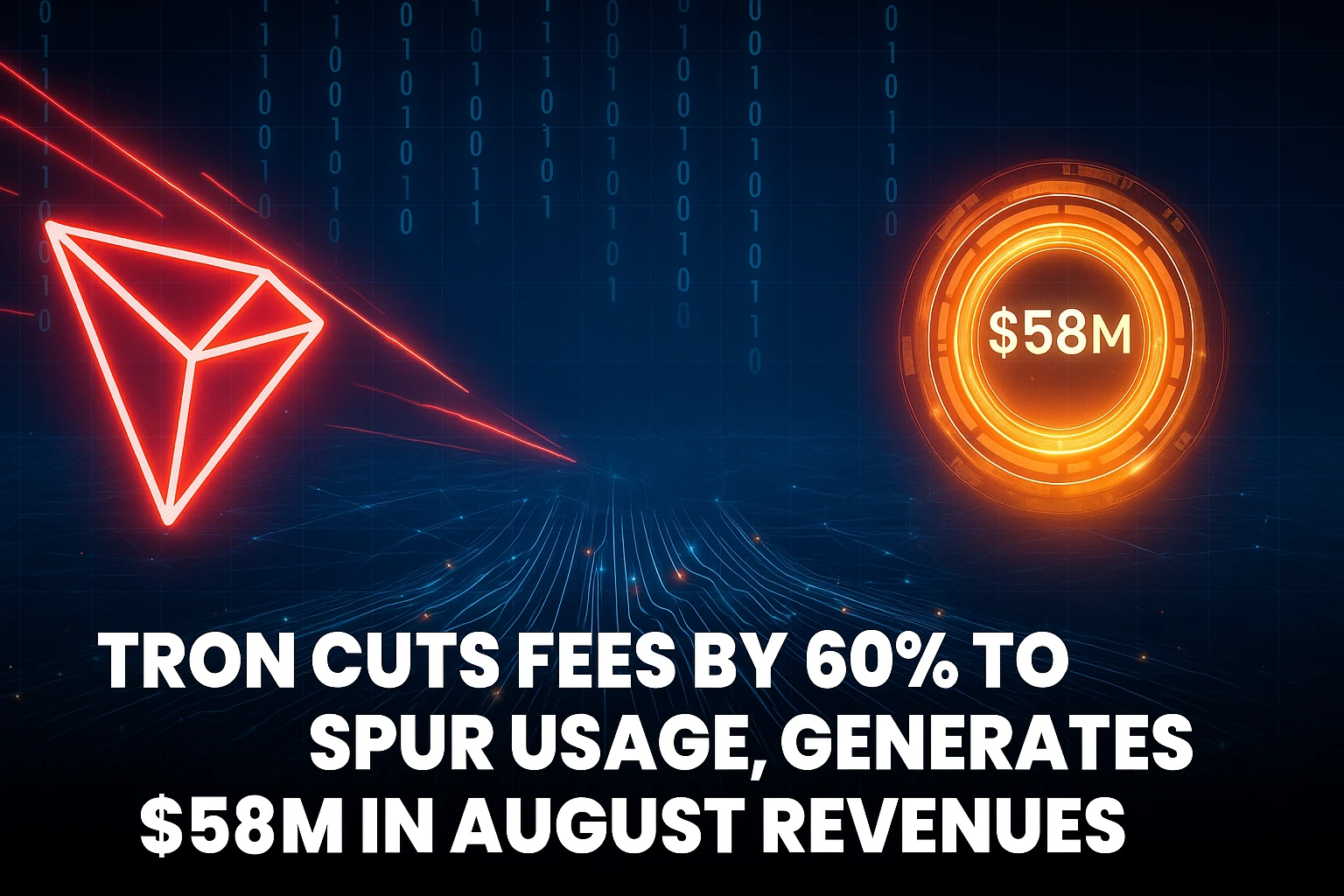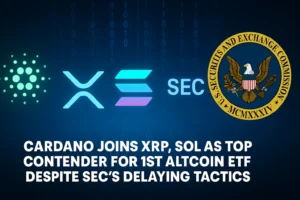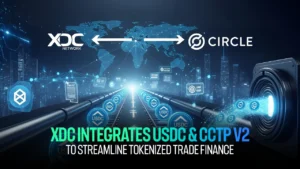Tron Cuts Fees by 60% to Spur Usage, Generates $58M in August Revenues

Tron’s governance community delivered its most consequential economic reform to date on August 29, 2025, when its Super Representatives voted to slash network fees by 60 percent. The change, effective 20:00 GMT+8, lowers the cost of executing smart contracts and transactions by cutting energy unit prices from 210 sun to 100 sun.
- Why Tron Moved Now
- Revenue Trade-Offs in Focus
- Justin Sun Frames the Gamble
- Market Reaction: TRX Slides
- Competitive Pressures Intensify
- Developers Welcome Relief
- Global Remittances in Play
- Historical Parallels in Blockchain Economics
- Analysts Split on Strategy
- Quarterly Reviews Signal New Approach
- Investor Confidence Tested
- Long-Term Implications for DPoS
- Conclusion
- Frequently Asked Questions About TRON Fee Reduction
- What exactly did TRX change?
- How much revenue will Tron lose?
- Who approved the change?
- Why did TRX act now?
- How did TRX respond?
- What competition does Tron face?
- How will this help developers?
- What about stablecoins?
- Will fees change again?
- What’s at stake for governance?
- Glossary of Key Terms
Founder Justin Sun called the move the “largest fee reduction since the founding of Tron,” underscoring its rarity in blockchain economics. Sun positioned the cut as a calculated sacrifice aimed at reinforcing Tron’s role as the leading global settlement layer for stablecoins.
The decision highlights the effectiveness of Tron’s Delegated Proof of Stake (DPoS) system, which enables a small group of elected validators to approve significant protocol changes rapidly.
Why Tron Moved Now
TRX’s price has doubled since 2024, inflating the cost of on-chain activity. Developers and users complained that fees had become misaligned with Tron’s mission of low-cost accessibility.
For a blockchain that processes more than half of global Tether (USDT) transfers, cost sensitivity is critical. Recent data shows:
- 8–9 million daily transactions
- 2.4 million active addresses
- 3,000–5,000 new smart contracts deployed daily
Despite robust activity, rising costs threatened future growth. By cutting fees, Tron is prioritizing adoption over immediate revenue.
ALSO READ: 21Shares Files For SEI ETF with Staking Option as SEC Considers Altcoin Approvals
Revenue Trade-Offs in Focus
TRON generated $58 million in fee revenue in August alone. Cutting costs by 60 percent could reduce that figure to $19–$ 23 million per month, erasing nearly $28 million in income.
| Metric | Value |
| Avg Monthly Fee Revenue (2025) | $47.7 million |
| August Fee Revenue Pre-Cut | $58 million |
| Estimated Revenue Drop (60%) | ~$28 million |
| Projected Monthly Revenue Post-Cut | ~$19–23 million |
This trade-off places Tron in an unusual position, accepting short-term financial losses in pursuit of long-term scale.
Justin Sun Frames the Gamble
In remarks following the vote, Sun emphasized that such reforms are rare but essential.
“This is the largest fee reduction since Tron’s founding,” Sun said. “We do not take such measures lightly, but when costs rise to a level that threatens adoption, decisive action is required.”
By framing the change as both bold and necessary, Sun reinforced the narrative that Tron’s DPoS governance can adapt faster than more rigid networks like Ethereum.
Market Reaction: TRX Slides
Investors responded cautiously. TRX fell 3.6 percent in the 24 hours after the announcement, slipping to $0.33–$0.34.
Technical indicators reflected neutral sentiment:
- RSI near 48
- MACD tilting bearish
- Resistance at $0.36
Analysts said the decline reflected uncertainty about revenue impacts rather than rejection of the strategy.
On social media, commentary was sharp.
Tron slashes fees by 60% to boost on-chain activity risking $28 million hit to revenuehttps://t.co/KFIf4YsL9f
— John Morgan (@johnmorganFL) August 29, 2025
Competitive Pressures Intensify
TRX’s dominance in stablecoin transfers is being tested. Bitfinex’s Plasma chain recently launched with zero-cost USDT transfers, directly challenging Tron’s main use case. Meanwhile, Polygon PoS, Solana, and Ethereum layer-two networks continue to promote low fees and high throughput.
By cutting fees more aggressively than rivals, Tron hopes to neutralize competition. Few blockchains have risked such deep cuts, particularly given the immediate revenue hit.
Developers Welcome Relief
For developers, the cut is a clear win. Tron’s Energy and Bandwidth model often required significant TRX staking to sustain dApp deployment. Lower energy costs make it cheaper to launch and run applications across DeFi, NFT markets, and GameFi.
Developers on social media hailed the decision as a return to TRX’s roots of accessibility. Several noted that lower costs could revive interest in deploying new decentralized apps, potentially boosting overall transaction volume.
ALSO READ: ARK Invest’s Stake in BitMine Surges Beyond $300M as Ether Treasury Model Gains Traction
Global Remittances in Play
The fee reduction also underscores Tron’s significance in global remittance flows. In markets such as Latin America, Africa, and Southeast Asia, where transaction costs can significantly impact adoption, Tron’s lower fees may solidify its position as the blockchain of choice for cross-border transfers.
Stablecoins like USDT have already emerged as a de facto remittance currency in several emerging economies. TRX’s ability to maintain low-cost settlement gives it an edge not just over other blockchains but also over traditional fintech rails.
Historical Parallels in Blockchain Economics
Few precedents exist for blockchain slashing fees so sharply. Ethereum’s EIP-1559 reform stabilized fees and introduced a burn mechanism, but did not reduce costs outright. Solana and Polygon have maintained low fees from inception, whereas Bitcoin’s model is tied to block rewards.
TRX’s approach is closer to a loss-leading strategy in traditional finance, sacrificing revenue to maintain dominance in a crucial sector. Whether this proves sustainable remains to be seen.
Analysts Split on Strategy
Research from AInvest argued the cut was overdue, saying TRX’s appreciation had “unintentionally priced out” ordinary users. Analysts framed the reduction as a necessary recalibration rather than a gamble.
Others were more critical. CoinLaw.io warned that Tron’s heavy reliance on stablecoin transfers exposes it to volatility: “When a network depends on one asset class, its economics become fragile. Tron risks undermining its finances if volumes do not accelerate.”
Quarterly Reviews Signal New Approach
To ensure fees remain competitive, Tron introduced quarterly reviews tied to TRX price, transaction levels, and network growth. Adjustments will be voted on by Super Representatives, embedding flexibility into the governance system.
This mechanism could serve as a model for other blockchains. Static fee structures often struggle to adapt to token price fluctuations, whereas TRX’s DPoS system enables regular recalibration without lengthy protocol upgrades.
Investor Confidence Tested
Institutional investors are watching closely. The revenue decline is material, and TRX’s long-term bet depends on transaction growth outpacing losses.
The coming months will determine whether adoption accelerates. Should volume increase, the strategy may prove prescient. If not, it could test confidence in both Tron’s governance model and its financial durability.
Long-Term Implications for DPoS
The episode also raises questions about Delegated Proof of Stake itself. While DPoS allows rapid responses, it concentrates decision-making power in a small group. Critics argue that such systems can overcorrect without adequate checks.
Tron’s case will be a key test. If the gamble succeeds, DPoS will be validated as an adaptive, responsive governance framework. If it fails, calls for more decentralized oversight may grow louder.
Conclusion
Tron’s 60 percent fee reduction is one of the most dramatic economic decisions taken by a major blockchain in recent years. Executed through Delegated Proof of Stake governance, it reflects both the flexibility and risks of DPoS systems.
By sacrificing up to $28 million in monthly revenue, TRX is betting that user adoption, stablecoin flows, and developer activity will scale enough to offset the hit. The decision underscores how competitive pressures and user needs increasingly drive blockchain policy.
Whether the gamble cements TRX’s dominance or exposes vulnerabilities will depend on adoption metrics in the months ahead.
Frequently Asked Questions About TRON Fee Reduction
What exactly did TRX change?
TRX reduced its energy unit cost from 210 sun to 100 sun, cutting fees by 60 percent.
How much revenue will Tron lose?
Around $28 million per month, based on recent averages.
Who approved the change?
TRX’s Super Representatives are elected validators under the Delegated Proof of Stake system.
Why did TRX act now?
Rising TRX prices inflated fees, slowing adoption, and discouraging developers.
How did TRX respond?
TRX fell around 3.6 percent after the news, trading at $0.33–$0.34.
What competition does Tron face?
Rivals include Solana, Polygon, Ethereum L2s, and Bitfinex’s Plasma chain.
How will this help developers?
Lower costs make deploying and running dApps more affordable.
What about stablecoins?
Tron still processes more than half of all Tether transactions, and the cut could reinforce that dominance.
Will fees change again?
Yes, Tron will conduct quarterly reviews to adjust based on network data.
What’s at stake for governance?
The move is a test of whether DPoS can deliver sustainable, community-led economic decisions.
Glossary of Key Terms
- Delegated Proof of Stake (DPoS) – A Governance model where elected validators vote on changes.
- Super Representatives (SRs) – Tron’s elected nodes responsible for protocol decisions.
- TRX – Native token of the Tron network.
- Energy – Resource for smart contracts.
- Bandwidth – Resource for transactions.
- Tether (USDT) – Stablecoin heavily used on Tron.
- Plasma (Bitfinex) – Rival chain offering free USDT transfers.
- Transaction Fees – Costs charged for network usage.
- Revenue – Network income from transaction fees.
- Adoption – Level of user and developer activity.




